
|
|
|
Winter 1997 Vol.1 COVER STORYEvoking History with ArtThe multicultural life and work of Chris Soentpiet
Soentpiet, a Korean American, has chosen a youthful audience for his paintings. He is a children's book illustrator, in fact, one of the hottest new names in a very competitive market. His paintings in the recently published "Peacebound Trains" (by Korean American Haemi Balgassi) bring history to life in a sensitive retelling of the flight of thousands of Koreans from north to south, in front of the advancing North Korean army, as the Communists took over almost all of South Korea at one point during the war. Many older Korean Americans have childhood memories of this tense journey on jam-packed trains. Many also remember, as the grandmother related in the book, sitting precariously on the roof of the train on a winter night as it sped south to safety. This scene is recreated in one of the book's paintings. And many also have been separated from family members forever as a result of this flight, as the grandmother was from her husband in the book. Although Soentpiet said it was very meaningful for him to collaborate on the "Peacebound Trains" project, even more so because he combined the research for the book with his first trip back to Korea since his adoption in 1978, Soentpiet has chosen a wide range of subject matter in the manuscripts he has illustrated, in part, he believes, because of his own background. Soentpiet seems very open and comfortable with the story of his
adoption and life in the United States, often telling funny stories
at his own expense about the ups and downs of it. Their adoptive family consisted of a German-English American mother,
a. Dutch-Indonesian father, two birthdaughters and a birth son,
who were older than Soentpiet and his sister, and a native Hawaiian
little brother, adopted as an infant at the same time as they were.
"Kauii has some Koreans, and there are a lot of people there of
mixed backgrounds, so we fit in well there, but about a year late
(after the adoption), we moved to a suburb of Portland, Oregon, and
the only other minority were the African-Americans," he recalled. Moving to New York City to attend the prestigious Pratt Institute, located in the Brooklyn neighborhood where he lives now, was refreshing in the opportunities he had to meet other people of varied backgrounds. He was an advertising student until almost the end of his program, and then, over the objection of his advisor, he changed it to Painting for his final project. He graduated in 1992, and the paintings from that final project were the content for his first book Around Town, a sort of travelogue of New York City from a child's point of view. Although he got a contract for the Around Town paintings in '92 after a couple months of pounding the pavement, he had no appreciable income for a couple of years while that book was being marketed and he was working, on other books - The Last Dragon, a story of a Chinese-American boy who renovates a dragon for a New Year parade, and More Than Anything Else, a fictionalized story of the life of Booker T. Washington were published before Peacebound Trains. "I lived in a small room with my college roommate, and got by with a job creating molds for belt buckles, and by doing some construction. I also borrowed money from my family, roommate, and my sister to get by," he said. "I always wanted to buy the best paints, and often it literally came down to 'should I eat an extra meal or buy this paint,' " he remembered. The way Soentpiet prefers to work on illustrations is by doing "research" in the form of taking photographs of various locations and objects, so that his rendering will be as accurate as possible. He also makes use of models, sometimes friends and acquaintances, and more recently, professional models who can take direction, pose, and are not intimidated by cameras or lights. In the case of Peacebound Train, he even purchased some period costumes in Korea, and had the models wear them. Although he uses real people and places to create his images, his imagination sticks all the pieces together into a final product. All these techniques take a lot of time, solitude, and money, none of which he had very much of during the his first two years in the real world of professional illustration. Finally, money started coming in after a couple of years, and with it, the management work for contracts, appearances, and other work usually done by agents increased exponentially. 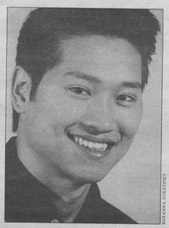
His wife Yin, eventually decided to quit her job and to do the management duties for him. His fifth book Silver Packages, an Appalachian Christmas story, is due to be published this fall, and he has contracts for four more projects after that. He is booked up, so to speak, until approximately the year 2000. The Soentpiets are now comfortably ensconced in a Brooklyn brownstone house, both working at home, in a New York neighborhood full of culturally diverse, creative people. Things are definitely looking up. One of the book contracts is for an autobiography, to be written for junior high readers, tentatively entitled Gift from Korea. Soentpiet describes this book as one he feels compelled to do, as part of working out his life story for himself, as well as for the benefit of other adoptees. He's been working on it off and on over a five year period. "It's coming along slow, but I don't care how long it takes, or even if I make any money from it. It's something I need to do." Since his trip to Korea in 1994, he has done much more thinking about his own personal history, and the history of the Korean people. He learned a lot on the trip, he said, but the language barrier was a constant frustration. "When I walked off that plane for the first time in 16 years every emotion you can think of comes to your head, and at the same time I couldn't express myself at all," he said. He also had to get used to Korean emotional restraint. While he was ready to hug and kiss his siblings, it was obvious they were planning only to shake hands! He was fortunate, he said, that his next older sister, the only sibling who is bilingual, came along with him to translate. "No way could I have done it without her," he said. He also visited the museum in Seoul that is dedicated to the war, and saw models of the "peacebound trains" as well as half-sized models of people in period costume. He did a tremendous amount of research and took 80 rolls of film for the book, he said, including pictures of the countryside and the housing, much of which is the same today as in the '50s. "Once I dove into it, I started to really understand what happened to cause the war, and what happened to all of the orphans and to the history of Korea because of the war." Although in recent years he has been feeling much more like a person with roots in Korea, Soentpiet said, he tends to pick multicultural themes, particularly since the popularity of Peacebound Trains allowed him some freedom of choice in the books he selects, to illustrate. So far, he summed up, he has done a book on New York, one that takes place in Chinatown, an African-American fictionalized biography, a story about wartime Korea, a book about the culture of Appalachia, and in the works is a story about Japanese American internment, and one about Lebanese immigration to the U.S., in addition to the autobiography. "I know a lot of people would think, well, you're Asian, so why don't you do Asian books?" and there are artists who are Asian and do stick to Asian subjects. But I've never felt I could do that," he reflected. "When I look at the choices I've made, I relate that to the kind of life I've lived. I have a German mom, and an Indonesian dad, a Hawaiian brother, Korean (birth) brothers and sisters, and a Chinese wife, and I've lived in Hawaii, Alaska, Oregon and now this neighborhood in New York. I've also visited a lot of countries. That's all part of who I am now." |
|
|
|
|
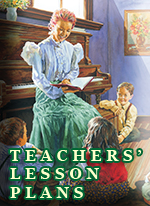
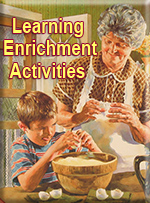
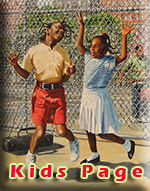

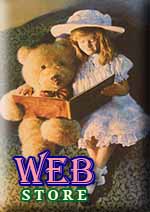
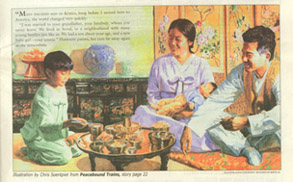 Chris
Soentpiet creates not only thoughtful paintings with figures that
evoke energy, depth of character, and dignity. he also strives to
render as accurate a snapshot of history as he possibly can.
Chris
Soentpiet creates not only thoughtful paintings with figures that
evoke energy, depth of character, and dignity. he also strives to
render as accurate a snapshot of history as he possibly can.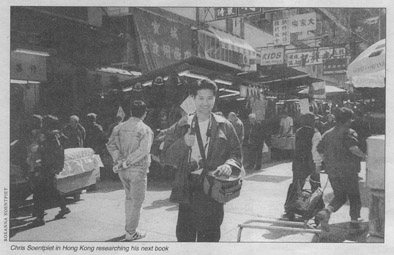 Born
in 1970 in Seoul, South Korea, Soentpiet (Kun Seop Han), is the
youngest of six siblings, including a brother and four sisters.
When he was six, his mother died of a brain tumor, and about a year
later, his father died in a car accident. The family was Mormon
at that time, and his oldest sister, then 22, moved to Hawaii for
about a year, and arranged for the adoption of eight-year-old Chris
and his 12year old sister through a large Mormon adoption agency
there.
Born
in 1970 in Seoul, South Korea, Soentpiet (Kun Seop Han), is the
youngest of six siblings, including a brother and four sisters.
When he was six, his mother died of a brain tumor, and about a year
later, his father died in a car accident. The family was Mormon
at that time, and his oldest sister, then 22, moved to Hawaii for
about a year, and arranged for the adoption of eight-year-old Chris
and his 12year old sister through a large Mormon adoption agency
there.